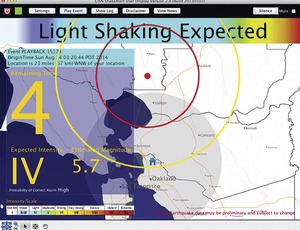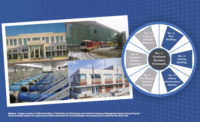
An earthquake-detection system under development by the University of California's Berkeley Seismological Laboratory proved its mettle on Aug. 24 by issuing a warning 10 seconds before a magnitude-6 temblor struck south of Napa, Calif. The alert could have gone out 2.5 seconds sooner if the ShakeAlert system, based on Japan's primary-wave detection system, were funded, and the lab were able to install more sensors, says a lab spokesperson.
"It was definitely a great proof-positive that the system works just like we'd hoped," says Jennifer Strauss, the lab's external relations officer. "One of the things the Napa quake did show us is you need to make sure there are enough sensors," says Strauss.
Bay Area Rapid Transit is testing the alert system and received eight seconds' warning, but none of its trains were running when the quake hit at 3:30 a.m.
California State Legislature unanimously passed Senate Bill No. 135 last year, which calls for the development of a comprehensive statewide earthquake early-warning system to alert Californians in advance of dangerous shaking. But funding has not yet been found.
"It's an unfunded mandate, stipulating that we can't use general funds for the system," says Strauss. "Both Mexico and Japan built their early-warning systems after massive damaging earthquakes. This is the chance for California to build one before such a damaging quake."
Schools Undamaged
The epicenter of the American Canyon quake was at the heart of the Napa school district's 30 campuses. Subsequently, three architectural and engineering teams assessed "every room in every school" and observed no structural damage following the quake, says Mark Quattrocchi, principal of Quattrocchi Kwok Architects and one of the survey team members. “While there was some non-structural damage such as broken windows and light fixtures at some schools, the high school we just completed for the District, American Canyon High School, did not even have cracked drywall. All district-wide students were back in the classrooms within two days,” he says.




Post a comment to this article
Report Abusive Comment